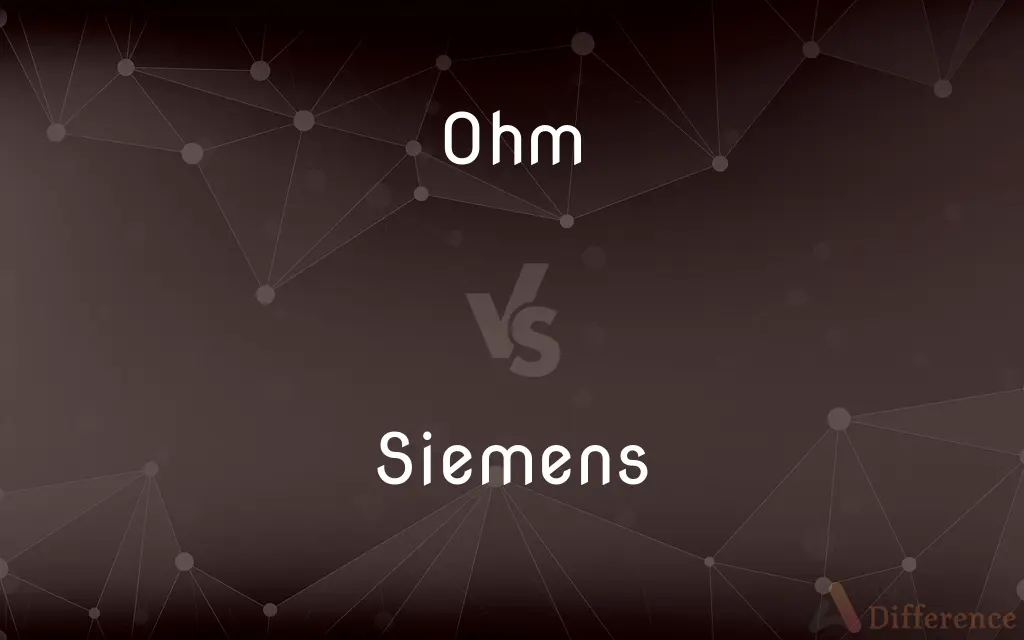Ohm vs. Siemens — What's the Difference?
By Urooj Arif & Maham Liaqat — Updated on May 12, 2024
Ohm measures electrical resistance, where higher values indicate greater opposition to current flow; Siemens measures conductance, where higher values signify easier current flow.

Difference Between Ohm and Siemens
Table of Contents
ADVERTISEMENT
Key Differences
Ohm is the unit of electrical resistance in the International System of Units (SI), symbolized by Ω. It represents how much a device or material opposes the flow of electric current. Whereas Siemens, denoted by S, is the SI unit of electrical conductance, the reciprocal of resistance, indicating how easily an electrical current can pass through a conductor.
Resistance in ohms quantifies how a device reduces the flow of electric current, influenced by both the material's properties and its dimensions. On the other hand, conductance in Siemens measures the ease with which current flows, also dependent on materials and geometry, but emphasizing the facilitation of current flow.
Ohm is calculated as the ratio of voltage to current (V/I) according to Ohm’s Law, useful in describing how voltage and resistance impact current. Whereas Siemens is derived from the reciprocal of resistance (1/R), relevant in contexts where the ability to transmit electrical current efficiently is critical.
High resistance indicates that a material or device restricts electron flow significantly, useful in applications like resistors in electronic circuits. Conversely, high conductance indicates minimal resistance to electron flow, advantageous in conductors and other components designed to maximize electrical transmission.
In practical applications, devices such as resistors are rated in ohms, indicating their capacity to hinder electrical current under specific conditions. On the other hand, devices like cables and connectors might be rated in Siemens, highlighting their efficiency in facilitating current passage.
ADVERTISEMENT
Comparison Chart
Definition
Unit of electrical resistance
Unit of electrical conductance
Symbol
Ω
S
Measurement
Voltage divided by current (V/I)
Reciprocal of resistance (1/R)
High Value Implication
Indicates greater opposition to current flow
Indicates easier current flow
Usage Context
Used in resistors, insulators
Used in conductors, transistors
Compare with Definitions
Ohm
The SI unit for measuring electrical resistance.
A resistor with a value of 10 ohms limits the current more than a 5 ohm resistor.
Siemens
The property of a material to allow the flow of electric current, measured in Siemens.
Silver has a high conductance, making it an efficient conductor.
Ohm
A generalization of resistance in alternating current (AC) circuits, measured in ohms.
The impedance of an inductor increases with frequency.
Siemens
The SI unit for measuring electrical conductance.
A conductor with a conductance of 1 Siemens allows one ampere of current per volt across it.
Ohm
A component used to control current in circuits, described in ohms.
Adding a 100 ohm resistor into a circuit reduces the current flow significantly.
Siemens
A material or device that transmits electricity, characterized by its conductance in Siemens.
Good conductors have high Siemens ratings to facilitate energy efficiency.
Ohm
The property of a material measured in ohms.
Copper has a lower resistance than iron, which is why it is a better conductor.
Siemens
The measure of how easily a circuit or device allows electric current to pass, expressed in Siemens.
High admittance in a circuit means it has a low level of resistance.
Ohm
The principle stating that the current through a conductor between two points is directly proportional to the voltage across the two points and inversely proportional to the resistance.
Ohm's Law is essential for calculating the needed resistance in circuit design.
Siemens
Siemens is the reciprocal of ohm, linking conductance to resistance.
If a device has a resistance of 2 ohms, its conductance is 0.5 Siemens.
Ohm
The ohm (symbol: Ω) is the SI derived unit of electrical resistance, named after German physicist Georg Ohm. Various empirically derived standard units for electrical resistance were developed in connection with early telegraphy practice, and the British Association for the Advancement of Science proposed a unit derived from existing units of mass, length and time, and of a convenient scale for practical work as early as 1861.
Siemens
Siemens AG (German pronunciation: [ˈziːməns] or [-mɛns]) is a German multinational conglomerate corporation and the largest industrial manufacturing company in Europe headquartered in Munich with branch offices abroad. The principal divisions of the corporation are Industry, Energy, Healthcare (Siemens Healthineers), and Infrastructure & Cities, which represent the main activities of the corporation.
Ohm
The SI unit of electrical resistance, transmitting a current of one ampere when subjected to a potential difference of one volt.
Siemens
A unit of electrical conductance in the International System, equal to one ampere per volt.
Ohm
The SI unit of electrical resistance, equal to the resistance of a conductor through which a current of one ampere flows given a one-volt potential across the conductor. See Table at measurement.
Siemens
In the International System of Units, the derived unit of electrical conductance; the electric conductance in a body that has a resistance of one ohm. Symbol: S
Ohm
In the International System of Units, the derived unit of electrical resistance; the electrical resistance of a device across which a potential difference of one volt causes a current of one ampere. Symbol: Ω
Siemens
A unit of conductance equal to the reciprocal of an ohm
Ohm
The standard unit in the measure of electrical resistance, being the resistance of a circuit in which a potential difference of one volt produces a current of one ampére. As defined by the International Electrical Congress in 1893, and by United States Statute, it is a resistance substantially equal to 109 units of resistance of the C. G. S. system of electro-magnetic units, and is represented by the resistance offered to an unvarying electric current by a column of mercury at the temperature of melting ice 14.4521 grams in mass, of a constant cross-sectional area, and of the length of 106.3 centimeters. As thus defined it is called the international ohm.
Siemens
Engineer who was a brother of Ernst Werner von Siemens and who moved to England (1823-1883)
Ohm
A unit of electrical resistance equal to the resistance between two points on a conductor when a potential difference of one volt between them produces a current of one ampere
Siemens
German electrical engineer (1816-1892)
Ohm
German physicist who formulated Ohm's Law (1787-1854)
Common Curiosities
In which situations is Siemens used?
Siemens is used in measuring the ease of electric current flow, typical in conductors and transmission materials.
How are ohms and Siemens related?
Siemens is the reciprocal of ohms; they inversely relate to each other.
Why is high Siemens value important in electronics?
High Siemens values indicate low resistance, crucial for efficient energy transmission in electronics.
Why would engineers need to know the Siemens value of a material?
Knowing the Siemens value helps in designing systems that require efficient current flow, such as in power grids.
What does an ohm measure?
An ohm measures the electrical resistance of a conductor.
What does a Siemens measure?
A Siemens measures the electrical conductance of a conductor.
In which situations is ohm used?
Ohm is used in measuring the opposition to electric current, common in resistors and insulating materials.
Can a high ohm value affect electronic devices?
Yes, a high ohm value can limit the current flow, affecting the performance of electronic devices.
Is resistance always undesirable?
No, resistance is essential in applications like controlling current flow and generating heat in devices.
What tools measure ohms?
Ohmmeters and multimeters are commonly used to measure resistance in ohms.
Does the length of a conductor affect its ohm and Siemens values?
Yes, the length affects both values; longer conductors have higher resistance and lower conductance.
Can both ohms and Siemens be zero?
Theoretically, yes, but practically, it's rare and occurs under specific conditions like superconductivity.
How do temperature changes affect ohms and Siemens?
Generally, increasing temperature increases resistance (ohms) and decreases conductance (Siemens).
What are practical examples of high resistance and high conductance devices?
High resistance devices include heaters and light bulbs; high conductance devices include power cables and switches.
What tools measure Siemens?
Conductance meters and multimeters can measure electrical conductance in Siemens.
Share Your Discovery

Previous Comparison
Dined vs. Dinned
Next Comparison
Autograph vs. AutogramAuthor Spotlight
Written by
Urooj ArifUrooj is a skilled content writer at Ask Difference, known for her exceptional ability to simplify complex topics into engaging and informative content. With a passion for research and a flair for clear, concise writing, she consistently delivers articles that resonate with our diverse audience.
Co-written by
Maham Liaqat












































